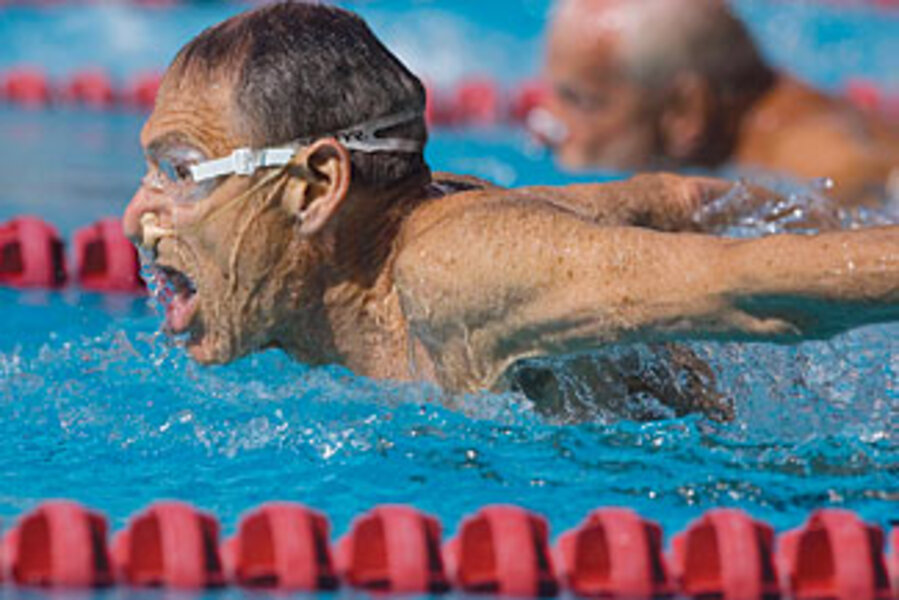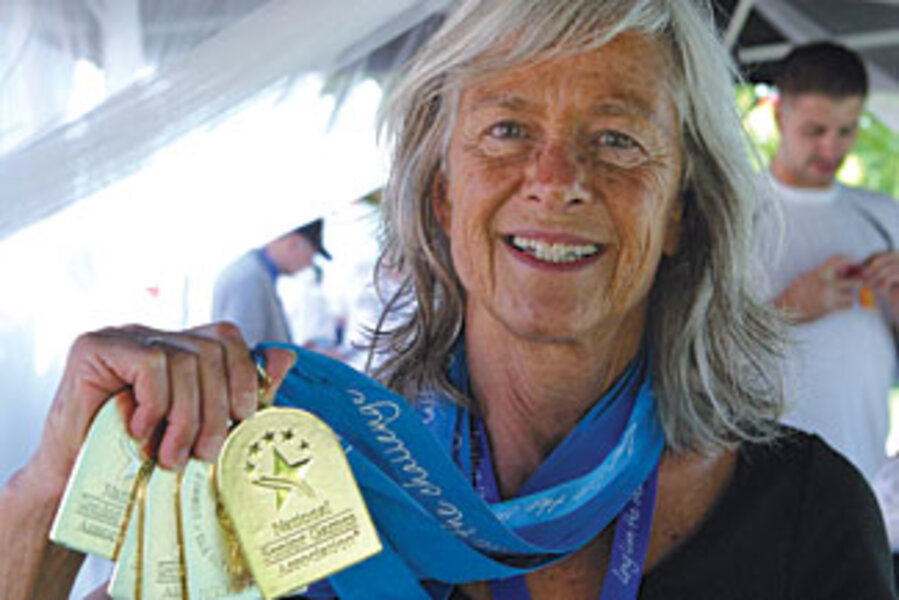A showcase for senior athletes
Loading...
| Palo Alto, Calif.
It's summer in California and the athletic facilities of Stanford University are abuzz with tanned, muscular men and women. But these aren't college athletes: August means it's time for the National Senior Games, the largest multisport event in the world for people 50 and over.
The games, which began Aug. 1 and run for two weeks, are made up of more than 800 events held at athletic facilities in Palo Alto, San Francisco, Sunnyvale, and San Jose. Sports include archery, badminton, racquetball, tennis, swimming, track and field, and volleyball.
"We provide a true championship in each of the sports that we offer," says Phil Godfrey, president and CEO of the National Senior Games Association.
The games are held every other summer, and this year about 10,000 athletes and 25,000 family members and friends are expected to attend.
The National Senior Games Association was founded in St. Louis in 1985. Two years later, the first event attracted about 2,500 athletes from all over the United States to compete in 15 sports.
"It was a big hit," Mr. Godfrey says.
The association's mission soon evolved from a strictly sports emphasis to a focus on healthy lifestyles, he says. The group has satellite offices in every state except Oregon and North Dakota, and most states organize local games and activities to reach out to less athletic seniors.
But many of the participants in the National Senior Games are longtime athletes.
Cathie Hopkins, who is in her 50s, came to Palo Alto from the Midwest to play women's doubles tennis. She took up the sport when she moved to Kansas City about 20 years ago and wanted to find an activity that was social as well as athletic. She qualified for the games last September with her teammate, but Ms. Hopkins has had her eye on the games since a friend participated several years before.
"When I heard about it I said, 'I want to do that one day,' " she says.
Dana Wolcott and Jon O'Connor of Rochester, N.Y., both in their 60s, are on a basketball team that beat seven others from the state to qualify. The men, who are on the younger side for the event, say they enjoyed seeing dedicated athletes many years older than themselves.
"Watching them compete is really inspiring," says Mr. Wolcott.
Typically, all basketball teams that are classified above age 79 qualify for the games – a perk the men jokingly say they look forward to.
"We're still kids," says Mr. O'Connor.
In fact, the games show that seniors can look forward to decades of athletics. The oldest participant is a centenarian: Roger Gentilhomme plans to take part in bowling and tennis singles. Estelle Frendberg, in her mid-90s, is the oldest female athlete, competing in the 1,500-meter race walk.
Virginia Smith, an octogenarian, took home three badminton medals Aug. 4 for women's singles, women's doubles, and mixed doubles. She met her husband playing badminton in 1941.
"It's a wonderful sport, it's good exercise, and it's a game you can play forever," she says.
Daniela Barnea glowed at the games as she ducked to receive yet another gold medal around her neck. She'd just broken the 41.39-second record for the 65-69 age group in the 50-yard butterfly, which had been in place since 2003. This was on top of breaking several other records.
Originally from Israel, Ms. Barnea was always athletic but wasn't competitive when she swam as a teenager, she says. When she came to Palo Alto 17 years ago, she started to swim for conditioning, but the desire to push herself soon kicked in: When her children participated in high school swimming and water polo, Barnea wanted to keep up.
"There was a competition between us. I wanted to swim and beat their times," she says.
In addition to enjoying the rush of winning, Barnea likes the meditative aspect of swimming: The sound and color of the water give her a place to relax and shed any worries from the day. She also enjoys eating what she wants. "I love my Häagen-Dazs at night, and I know I'll work it off the next day," she says.
Now, Barnea doesn't go anywhere without a swimsuit and goggles, and her workout takes priority in her life. She swims 1 to 1-1/2 hours a day and works out in the gym two or three times a week.
Like many participants at the games, Barnea was inspired by the athletes much older than she is.
"To get to be 90 is one thing, and to compete is just something else. It brings tears to my eyes," she says, adding, "I want to break their records when I get there."






